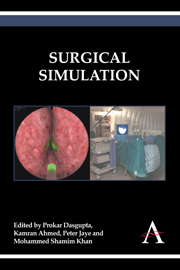Book contents
- Frontmatter
- Contents
- 1 Surgical Simulation: An Overview
- 2 Simulation in Historical Perspective: The History of Medical and Surgical Simulation
- 3 The Role of Animal Models in Surgical Training and Assessment
- 4 Full Procedural Surgical Simulation
- 5 Developing Non-technical Skills
- 6 Learning Curves for Simulators
- 7 Developing a Simulation Programme
- 8 Patient Safety and Simulation
- 9 Psychometrics
- 10 Future of Surgical Simulation
- Author Details
2 - Simulation in Historical Perspective: The History of Medical and Surgical Simulation
Published online by Cambridge University Press: 05 April 2014
- Frontmatter
- Contents
- 1 Surgical Simulation: An Overview
- 2 Simulation in Historical Perspective: The History of Medical and Surgical Simulation
- 3 The Role of Animal Models in Surgical Training and Assessment
- 4 Full Procedural Surgical Simulation
- 5 Developing Non-technical Skills
- 6 Learning Curves for Simulators
- 7 Developing a Simulation Programme
- 8 Patient Safety and Simulation
- 9 Psychometrics
- 10 Future of Surgical Simulation
- Author Details
Summary
Introduction
The word ‘simulate’ was originally derived from the Latin term simulare (to imitate) stemming from similis(similar), and therefore to simulate is to create likeness or to model (1). Simulation itself has been defined as ‘in industry, science, and education, a research or teaching technique that reproduces actual events and processes under test conditions’ (2). Simulation can include many activities such as clay pigeon shooting, practising fire drills or exercising on rowing machines. Surgical simulation itself can be defined as ‘an exercise that reproduces or emulates, under artificial conditions, components of surgical procedures that are likely to occur under normal circumstances’ (3).
Historical Overview
The aim of simulation is to aid the acquisition of specific skills and improve both competence and confidence. When we hear the term ‘simulation’ today we are likely to imagine the fully immersive high-fidelity simulators training airline pilots or astronauts, however, simulation has been a part of training for thousands of years, from hunter-gatherers throwing wooden spears while learning to hunt to target archers using the bow and arrow. In surgical training, using an orange to practise suturing skills or practising surgical knots on a table leg are methods of simulation that have been employed for many years. Perhaps the earliest contribution to the field of surgical simulation was by the ancient Indian surgeon, Sushruta Samhita (4).
- Type
- Chapter
- Information
- Surgical Simulation , pp. 15 - 22Publisher: Anthem PressPrint publication year: 2014



